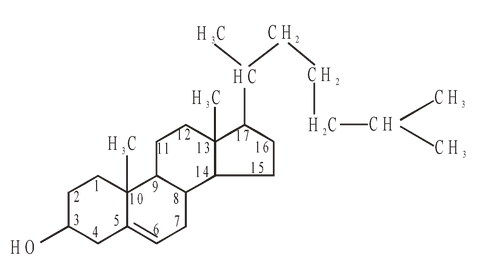
Types Of Lipids
Molecules of Cell of Class 11
Bloor (1943) classified lipids into three categories - simple, compound and derived.
(i) Simple Lipids : are formed of fatty acids and alcohol without any additional group e.g. true fats, wax, cutin, suberin.
(ii) Compound Lipids : Contain groups in addition to fatty acids and alcohol. Also called as conjugated lipids, e.g., phospholipids, sphingomyelins, glycolipids, sulpholipids, lipoproteins.
(iii) Derived Lipids : Derivatives of lipids or lipid-like substances, e.g. steroids and sterols like cholesterol, lipid soluble vitamins, lipid soluble hormones, terpenes, prostaglandins. True fats, cholesterol and other uncharged lipids are called neutral lipids.
Simple Lipids
True fats / Neutral fats / triglycerides
Esters of fatty acids and 3-carbon trihydric alcohol glycerol (= Glycerine).
Commonest lipids in nature and are further classified as fats or oils, according to whether they are solid (fats) or liquid (oils) at 20°C. The higher the proportion of unsaturated fatty acids, the more likely they are to be liquid at a given temperature.
Butter and its ghee are semi-solid due to presence of more of short-chain fatty acids.
Vegetable ghee is also hard fat due to conversion of unsaturated fatty acids into saturated ones during hydrogenation of oil.
Triglycerides are non-polar so they do not form hydrogen bonds with water molecules and therefore do not dissolve in water - they are hydrophobic. They are less dense than water and therefore float.
Their tails vary in length according to the particular fatty acids used. e.g. Tristearin made from three stearic acid molecules, so its tails are 17 carbon atoms long.
The ester is called diglyceride if glycerol combines with two molecules of fatty acids and monoglyceride if it happens to form ester linkage with only one fatty acid. All the three fatty
acids are similar in pure fats, e.g., tripalmitin, tristearin. One, two or all the three are dissimilar in mixed fats, e.g. dipalmitostearin, palmitodistearin, butter.
True fats are neutral in reaction. They do not have any colour, taste and odour. The same are provided by other ingredients. Fats are stored as droplets or globules. In animal bodies they
occur inside special cells called adipocytes. The tissue storing fat is called adipose tissue. In plants the fat is commonly stored in seeds, called as oil seeds, e.g. Rape seed, Mustard,
Sunflower, Cotton, Peanut (= Groundnut).
Lipids act as energy stores. They have a higher calorific value than carbohydrates, that is a given mass of lipid will yield more energy on oxidation than an equal mass of carbohydrate.
This is because lipids have a higher proportion of hydrogen and an almost insignificant proportion of oxygen compared with carbohydrates.
Animals store extra fat when hibernating and fat is also found below the dermis of the skin of vertebrates where it serves as an insulator. It is extensive in mammals living in cold climates,
particularly in the form of blubber in aquatic mammals such as whales, where it also contributes to buoyancy.
Plants usually store oils than fats. Seeds, fruits and chloroplasts are often rich in oils and some seeds are commercial sources of oils, for example the coconut, castor bean, soyabean and sunflower seed.
When fats are oxidised, water is a product. This metabolic water can be very useful to some desert animals, such as the kangaroo rat, which stores fat for this purpose.
Waxes
Chemically ‘inert’ esters of long chain saturated fatty acids with monohydric higher alcohols like oleyl, ceryl, cytyl, mericyl, etc.
On heating they become soft and pliable. On cooling they turn hard and water resistant. Waxes are common water repellent and lubricant lipids of plants and animals.
Lanolin (= lanoline) or wool fat is a wax secreted by cutaneous glands in fur bearing animals for providing a protective water proof coating to fur. It is an ester of cholesterol with a common fatty acid like palmitic, stearic or oleic acid. Similar water proof coating of wax occurs over feathers, human skin and insect skeleton.
Beeswax is secreted by worker bees from their abdominal glands for building honey combs. It is formed by esterification of palmitic acid with mericyl and hexacosyl alcohols.

Candle wax is a mixture of paraffin wax (from petroleum) and stearic acid. Cerumen or ear wax is secreted by modified sweat glands or ceruminous glands present in the ear canal. It lubricates ear drum. Commonest waxes in humans are esters of cholesterol.
Cutin
A lipid formed by polymerisation and cross-esterification of hydroxy fatty acids. Free fatty acids and fatty acids esterified with alcohol other than glycerol, also occur.
Occurs on outer epidermal walls of plant surfaces as binding agent that also reduces the rate of transpiration.
Alongwith wax, cutin forms a layer of cuticle on the surface of leaves and other soft organs.
Suberin
A lipid formed by esterification of phellonic acid or its derivative with glycerol. Occurs in the walls of cork cells and endodermal cells. It makes the cells wall impermeable to water.
COMPOUND LIPIDS
Phospholipids
Phospholipids are lipids containing a phosphate group. The commonest type is formed when one of the three –OH groups of glycerol combines with phosphoric acid instead of a fatty
acid. The other two –OH groups combine with fatty acids as in the formation of a triglyceride.

Fig. Formation of Phospholipid
The molecule consists of a phosphate head, with two hydrocarbon tails from the two fatty acids. The phosphate head carries an electrical charge and is therefore soluble in water, in other
words it is hydrophilic, or water-loving. The tails, however, are still insoluble in water. Thus one end of the molecule is soluble and the other is not. This is important in the formation of membranes.
Sphingomyelins
The lipids do not contain glycerol. Instead a complex amino alcohol sphingosine is found. It is esterfied with one fatty acid and a phosphocholine or phosphoethanolamine at its polar head.
Sphingomyelins occur in most animal membranes, also present in good quantity in myelin sheath of nerve fibres.
Glycolipids
Glycolipids are associations of lipids with carbohydrates. Two common glycolipids are :
Cerebrosides made of amino alcohol sphingosine, a fatty acid and sugar. The polar head group is neutral being made of sugar unit. Glucocerebrosides contain D-glucose in the head region. They are found in cell membranes. Galactocerebrosides have D-galactose in head region. They occur in cell membrane of brain cells.
Gangliosides made of sphingosine or dihydrosphingosine, fatty acid, glucose, galactose, N-acetylgalactosamine and sialic acid. Gangliosides are involved in ion transport and receptors for viral particles. They are found in grey matter.
Derived Lipids
Terpenoids or Terpenes : A large group of lipids that are formed by repeating units called isoprenes or isoprenoid units (C5H8) e.g. carotenoids, rubber, menthol, camphor, steroids, gibberellins, etc. Isoprene does not occur in nature but is available as isopentenyl pyrophosphate.

Carotenes : Carotenes are terpenoids with a general formula of C40H56. In plants they function as accessory photosynthetic pigments, as attractants for animals to perform pollination and fruit dispersal and to help in plant growth movements. Lycopene is a simple carotene of red colour that occurs in the ripe fruits of tomato and chilly. The most common carotene is -carotene. Rich in carrot root and all leafy
vegetables. -carotene is converted to vitamin A in animals. Vitamin A forms visual pigment rhodopsin.

Prostaglandins
A group of hormone-like derivative of unsaturated fatty acids which, function as messenger substances between cells, agents in blood clotting, smooth muscle contraction, allergic acid inflammatory reactions.
Prostaglandins are derived from arachidonic and related C20 fatty acids.
Prostaglandins occur in human seminal fluid, menstrual fluid, amniotic fluid and a number of tissues and also circulate in blood.
Steroids
A group of tetracyclic lipid-derivatives which have a nucleus of cyclopentane-perhydrophenanthrene with phenanthrene part made of 3 hexane rings while the fourth ring is a pentane. The skeleton has 17 carbon atoms. Two methyl groups occur at carbon atoms numbered 18 and 19.
Sterols are alcoholic derivatives which possess one or more hydroxyl groups. The most common sterol is cholesterol. Ergasterol occurs in cell membranes of fungi. Coprosterol is found in stool. It is formed by bacterial reduction of cholesterol. Stigmatosterol and sitosterol are plant sterols.
Steroid diosgenin obtained from Yam (Dioscorea) has property to prevent sperm formation in males. It is, therefore useful in producing male antifertility pill. Steroids are anabolic stimulants. Anabolic steroids are used in treating debilitating ailments where other medicines are not available. They are misused for body building. Synthetic stimulants are derived from testosterone.
Cardiac glycoside stropanthin is a steroid.
Birth control tablets possess steroid hormone progesterone.
Cholesterol
A fat soluble white crystalline sterol or steroid alcohol, C 27 H 45 OH. It has a 17-carbon nucleus of four fused hydrocarbon rings (3 hexane, one pentane; cyclopentano- perhydrophenanthrene). An eight carbon side chain is attached at carbon-17.
Found exclusively in animal food, especially meat, animal fat and egg yolk.
Normal cholesterol concentration of blood is 140-250 mg/100 ml.
Occurs both in free state as well as combined with fatty acids at its hydroxyl group at carbon 3. It also forms component of low density lipoproteins (LDL or α -lipoprotein, upto 46%), very low density lipoproteins (VLDL or pre- β -lipoprotein, 10-25%) and high density lipoproteins (HDL or -protein, 20%). Concentration of LDL and VLDL is found to increase in atherosclerosis and coronary thrombosis.

Functions :
Component of cell membranes in animals and wall-less bacteria called mycoplasma. Helps in formation of bile salts and bile acids.
Prevents premature breakdown of erthrocytes.
Forms vitamin D near the surface of irradiated skin.
Promotes absorption of fatty acids.
Transports fat to liver for metabolism.
Forms steroid hormones in the adrenal glands, viz. cortisol, cortisone and aldosterone.
Produces sex hormones - progesterone, estrogen (female sex hormones) and testosterone (male sex hormone).
Moulting hormone ecdysone is formed from cholesterol.
Cholesterol sometimes crystallises in gall bladder and produces gall stones.
On combination with a saturated fatty acid, cholesterol forms yellowish plaques in the walls of large and medium sized arteries. The walls become thick fibrotic and calcified. The
phenomenon is called atherosclerosis. It narrows lumen of arteries resulting in reduced flow of blood.
Lipoproteins
They are complex biomolecules formed of triglycerides, phospholipids, cholesterol and proteins. Lipoprotein are of four types - chylomicrons, high density lipoproteins (HDL), low density lipoprotein (LDL) and very low density lipoproteins (VLDL). Membranes are also lipoprotein structure. Lipids are transported in blood plasma and lymph in the form of lipoproteins.









